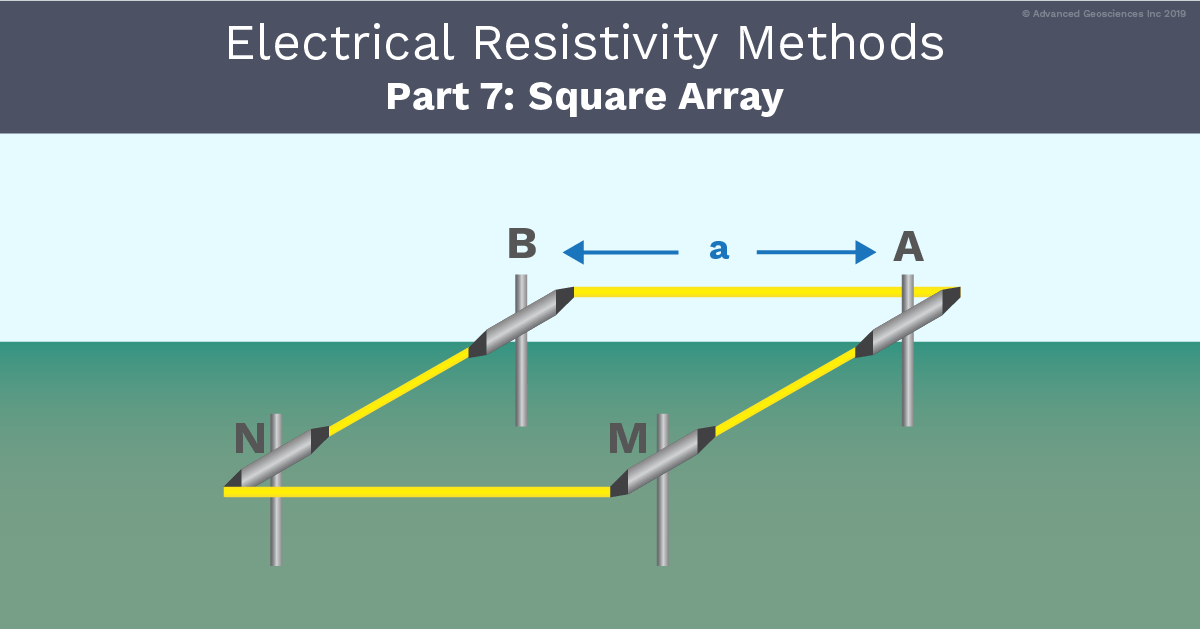
Welcome back to our series detailing the different electrode arrays that you may come across in your work. This is the seventh article in our series exploring 11 electrode arrays and methods. We’ve covered some of the standard arrays that will cover most of your bases. In the last post, we’ve started talking about some lesser known arrays. Today, we’re discussing another non-standard electrode array—the Square Array.
If you’re interested, we’ve also covered the following:
Part 2: The Schlumberger Array
Part 3: The Dipole-Dipole Array
A quick refresher on electrode arrays (in less than 30 words):
Electrode arrays are different arrangements of electrodes used to perform geophysical resistivity measurements. Electrode arrays were developed in order to make field measurements more efficient and data interpretation easier.
What is the Square Array?
The Square Array is a special case of the Equatorial Array. The name derives from the electrodes forming the shape of a square—with the four sides of the array being of equal length. This array was once used frequently in determining anisotropy, or the resistivity in different directions of a geological formation. Instead of expanding the electrodes, in Square Array surveys, the square is typically turned 15 degrees around its center point for each measurement.

The apparent resistivity for the Square Array depends on what ABMN geometry (K) you use. Below is the generic formula for apparent resistivity to get you started.

Benefits, Considerations, & Applications Of The Square Array
Benefits: As with the Equatorial Array, an advantage of the Square Array is that you are able to penetrate deeper into the ground than when using the Dipole-Dipole Array (assuming the length along the survey line is the same). As mentioned above, it is an array that was once good for determining anisotropy. However, 3D and linear 3D resistivity has since become a far better solution.
Consideration: As with all Azimuthal Arrays, the Square Array is measured in 1D. As with any 1D sounding measurement, there are significant drawbacks due to the necessary assumptions of this method. It is not possible to determine heterogeneity such as a tilted bed vs anisotropy like fractures within the bed. To tell the difference with the Square Array, you would need to run a grid of locations near each other which is prohibitively slow and costly in most parts of the world.
Again, with the development of 3D arrays, the need for the Square Array has diminished over the years. It’s often not used much in the U.S. anymore, though it still has some popularity in other countries. With a 3D array, you could easily see clearer data than what is provided by the Square Array. You can learn more about how 1D, 2D, and 3D surveys compare in this article. The Square Array is usually only used if the field conditions are right and if the survey operator has some base knowledge of fractures in the vicinity.
Applications: Square Array resistivity surveys would be a good fit for identifying environmental problems. Specifically, preferential flow paths and the way spills will flow and follow fractures.
Let’s say you’re a hydrogeologist that needs to survey a rock body with a fracture system. You'll want to locate the general fracture direction. Taking a number of readings through the square array, you can determine which direction is more conductive and thus the main direction of the fractures.
Furthermore, if you needed to see deeper to gain more information on fractures in the rock body, you could expand the size of the square and repeat the same procedure. It may, for instance, show that the fracture changes direction at a particular depth.
